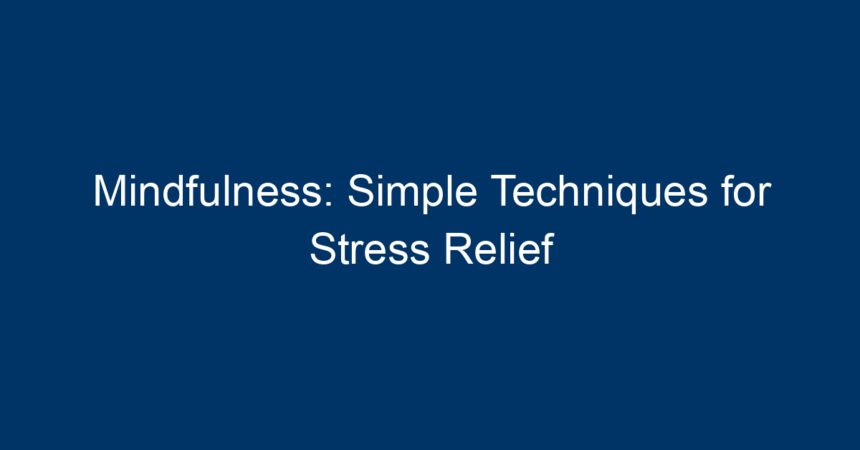In today’s fast-paced world, stress has almost become a part of everyday life. Whether it’s deadlines at work, personal obligations, or the endless stream of information we encounter, it often feels overwhelming. However, one practice that stands out as an effective antidote to stress is mindfulness. This article delves into simple techniques for stress relief through mindfulness, offering practical tips that can be integrated into your daily routine.
What is Mindfulness?
At its core, mindfulness is the practice of being fully present and engaged in the moment, aware of your thoughts and feelings without judgment. Originating from ancient Buddhist traditions, mindfulness has gained immense popularity in modern psychology for its myriad benefits, especially in stress management. When you cultivate mindfulness, you learn to navigate the ups and downs of life with poise, leading to a heightened sense of peace.
The Benefits of Mindfulness
Before exploring simple techniques, let’s take a moment to discuss why mindfulness is so effective in reducing stress. Practicing mindfulness can lead to:
- Reduced Anxiety: By focusing on the present, you can let go of worries about the future.
- Improved Emotional Regulation: Mindfulness helps you respond rather than react to stressors.
- Enhanced Focus: With regular practice, you’ll notice an improvement in your attention and concentration.
- Better Physical Health: Reducing stress through mindfulness can lower blood pressure, improve sleep, and support digestion.
Simple Mindfulness Techniques for Stress Relief
1. Mindful Breathing
One of the easiest and most effective mindfulness techniques is mindful breathing. This practice doesn’t require any special equipment or extensive training; you can do it almost anywhere!
How to Practice Mindful Breathing:
- Find a Comfortable Position: Sit or lie down in a place where you won’t be disturbed.
- Close Your Eyes: If you’re comfortable, close your eyes to limit distractions.
- Focus on Your Breath: Inhale deeply through your nose for a count of four. Hold your breath for a count of four, then exhale slowly through your mouth for a count of six.
- Repeat: Continue this cycle for several minutes, paying attention to how your breath feels as it enters and leaves your body.
2. Body Scan Meditation
A body scan is a great mindfulness technique that helps to cultivate body awareness. It can be particularly effective in releasing tension stored in different areas of the body.
How to Perform a Body Scan:
- Lie Down Comfortably: Start by lying flat on your back with your arms at your sides.
- Close Your Eyes: Gently close your eyes and take a few deep breaths.
- Focus on Each Body Part: Starting from your toes, mentally scan your body upward. Notice any sensations, areas of tension, or discomfort.
- Release Tension: As you focus on each part, consciously relax it, allowing the tension to melt away.
- Complete the Scan: Continue the process all the way up to your head, taking your time with each part of the body.
3. Mindful Walking
Walking is a simple activity most people do daily, but it can also become a form of mindfulness practice. Mindful walking encourages you to focus on the sensations and experiences of the act of walking itself.
Mindful Walking Steps:
- Choose Your Path: Find a quiet space, like a park or a tranquil path.
- Walk Slowly: Begin walking at a slow, deliberate pace. Pay attention to the feeling of your feet making contact with the ground.
- Engage Your Senses: Listen to the sounds around you, observe the scenery, and feel the breeze on your skin.
- Breathe: Coordinate your breath with your steps—inhale for a few steps and exhale for a few steps.
4. Mindfulness Journaling
Writing can be a powerful tool for processing your thoughts and emotions, particularly when integrated with mindfulness.
Practicing Mindfulness Journaling:
- Set Aside Time: Dedicate a specific time each day to write, even if it’s just for five minutes.
- Write Freely: Don’t censor yourself. Simply allow your thoughts to flow onto the page without worrying about grammar or structure.
- Reflect: After writing, read through what you’ve written and reflect on your feelings. This can help in identifying sources of stress and understanding your emotions better.
5. Guided Mindfulness Meditation
Guided meditation can be especially helpful for beginners. Numerous apps and online resources offer sessions led by experienced instructors.
How to Get Started with Guided Meditation:
- Choose a Platform: Find a meditation app like Headspace or Calm, or listen to mindfulness meditations on YouTube.
- Set Aside Time: Carve out a specific time in your day to meditate.
- Find a Quiet Space: Create a comfortable environment where you won’t be interrupted.
- Follow Along: Listen to the guide, and follow their instructions, focusing your mind on the present moment.
Overcoming Common Mindfulness Challenges
While integrating mindfulness into your routine can be incredibly rewarding, you may encounter challenges along the way. Here are some common obstacles and how to tackle them:
1. Constant Distraction
Many people struggle with a wandering mind. If you find it hard to stay focused, simply acknowledge the distraction and gently bring your attention back to your breath or the task at hand.
2. Lack of Time
Incorporating mindfulness doesn’t have to take a lot of time. Even a few minutes of focused breathing or a brief body scan can be impactful. Schedule mindfulness into your day like any other appointment.
3. Not Feeling ‘Zen’
Mindfulness isn’t about achieving a permanent state of calm. It’s normal to feel restless or uncomfortable in the beginning. Over time, with practice, these feelings will lessen.
Conclusion: Take Action with Mindfulness
Adopting mindfulness practices can transform how you respond to stress, enhance your emotional well-being, and improve your overall quality of life. Start small by incorporating one or two techniques from this article into your daily routine. Whether it’s mindful breathing for five minutes or a brief body scan before bed, each step counts toward a more mindful existence.
Remember, mindfulness is a journey, not a destination. Be patient with yourself and embrace the practice as you explore the wonderful benefits it offers. Transform stress into serenity and begin your mindfulness journey today!




